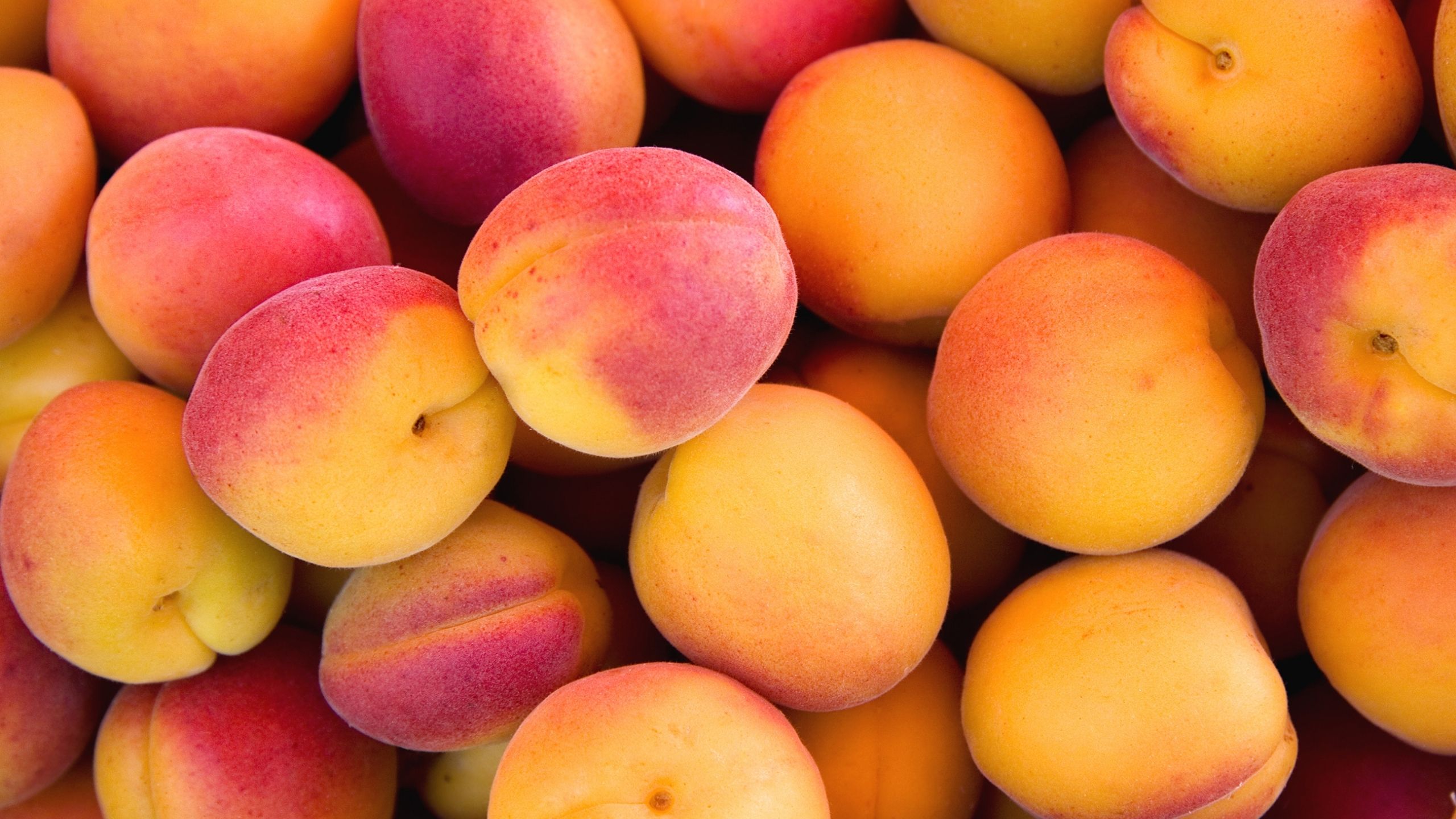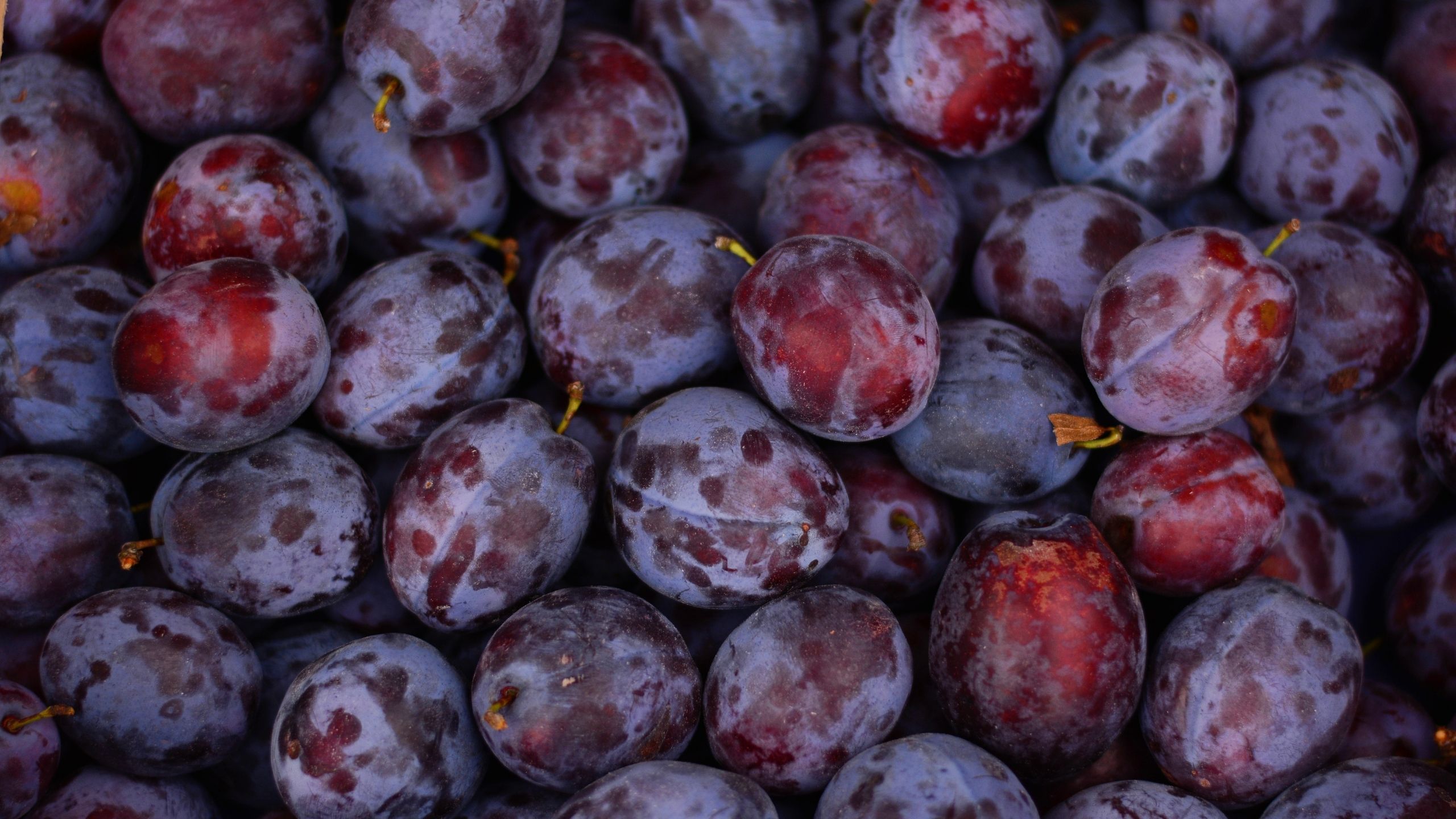Fruit Pests: Apple
The Backyard Orchardist
January 2020
Marion Murray, Extension IPM Specialist • Diane Alston, Extension Entomologist (No longer at USU)
DISEASES
(Listed in Order of Importance)
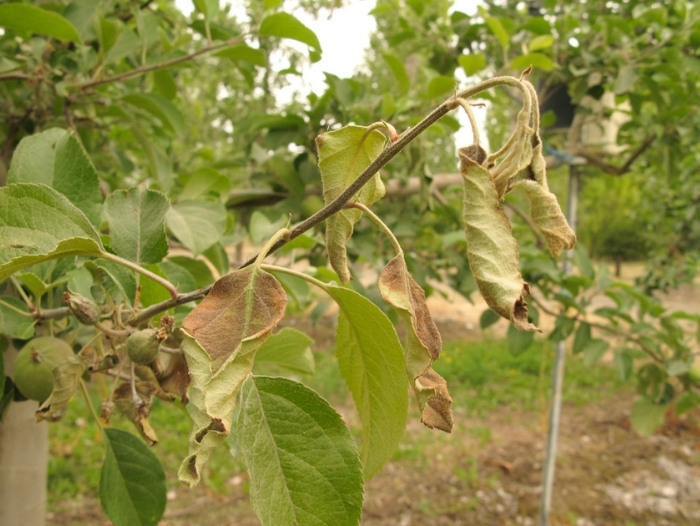
Fire Blight
Importance as a Pest on Apple: high
Other Fruit Hosts: crabapple and pear
General Info: Fire blight is caused by a bacteria called Erwinia amylovora. Some varieties of apples are very susceptible to this disease, such as Jonathan, Jonagold, and Gala. Blossoms, terminal twigs, and sometimes entire limbs or trees are killed. Environmental conditions favoring infection are moisture during bloom and when average temperature exceeds 60° F. Rain, heavy dew, and insects spread oozing bacteria to flowers, where new infections occur.
Symptoms:
- brown blossoms and shoots
- wilted shoots in the shape of a shepherd’s crook (shown right).
- infected twigs that retain dead leaves through winter
- oozing cankers in spring
Management: Most importantly, all infected shoots, twigs, and limbs should be pruned out of the tree as soon as they appear (start looking 2 weeks after bloom). Cut 12 inches below visible symptoms into healthy wood to be certain that the bacteria are removed. Do not prune during wet conditions, as this can contribute to disease spread. During bloom, protect flowers from infection by applying an antibiotic spray just before, or 24 hours after, rainfall. Mix the labeled rates of streptomycin and oxytetracycline to prevent resistance.
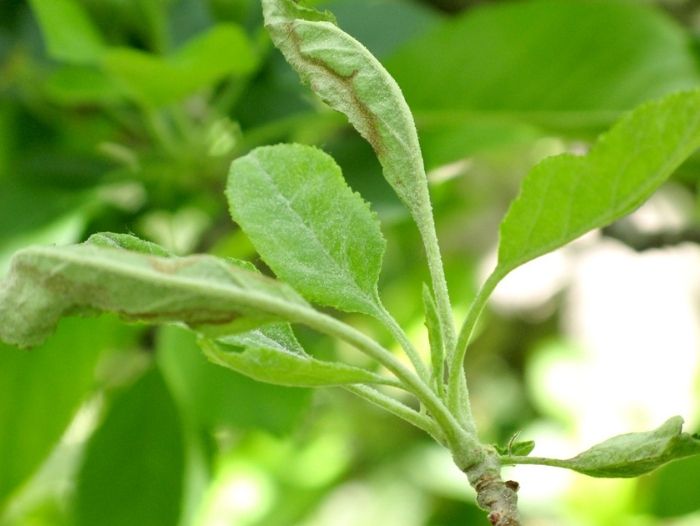
Powdery Mildew
Importance as a Pest on Apple: moderate-high
Other Fruit Hosts: cherry, nectarine, peach, berries, and grape
General Info: This fungus attacks leaves, flowers, and fruit. Certain apple varieties (Jonathan, Idared, Gala, Jonagold, Rome) are commonly attacked but others may also be affected in years of moisture and humidity. The fungus overwinters on twigs. Infections begin in late spring, during warm days, cool nights, and some form of moisture. The spores are spread by wind, dew, rain, and irrigation.
Symptoms:
- yellowing
- distortion
- stunting
- reduced yield
- white powdery residue (a mixture of fungal mycelium and spores)
Management: Most trees can tolerate light infections. Fungicides (sulfur, myclobutanil) work as preventives, and must be applied prior to infections. Start at open-cluster stage (before bloom) on trees that are prone to infection. Pruning affected twigs will also help reduce the pathogen levels in the area.

Iron Deficiency
Importance as a Pest on Apple: moderate
Other Fruit Hosts: nectarine, peach, and berries
General Info: Iron is a nutrient necessary for the formation of chlorophyll. Lack of chlorophyll means reduced photosynthesis, and reduced tree vigor. Iron deficiency is not caused by a lack of iron in the soil, but rather the soil pH (which ranges from 7.5 to 8.5 in Utah). In high pH, iron is insoluble, and therefore not available for root absorption. Because irrigation water is also very alkaline, trying to manage iron deficiency by reducing soil pH is impossible. Iron deficiency is exacerbated by frequent springtime irrigation or prolonged soil wetness. Some trees are genetically more susceptible to nutrient deficiencies than others.
Symptoms:
- interveinal chlorosis (yellowing between veins)
Management: To prevent or treat iron deficiency, chelated iron (in the form of FeEDDHA, such as Miller’s Ferriplus) can be applied to the soil or foliage, but results are temporary. (Chelated products are readily absorbed and are not affected by soil pH.) Soil applications should be made in the spring before leaves emerge, and worked into the root zone. For minor deficiencies, one application will last all season. Foliar sprays (0.1%) with a spreader-sticker provide quick results but must be reapplied at approximately 10- to 21-day intervals. The drawback of foliar sprays is that staining of fruit can occur. To accurately diagnose nutrient deficiencies, the USU Analytical Lab (435-797-2217) can test foliar and soil samples.

Crown Rot and Root Rot
Importance as a Pest on Apple: low-moderate
Other Fruit Hosts: all fruit trees
General Info: Caused by a soil-borne, fungus-like organism (Phytophthora), crown rot and root rot occurs worldwide on almost all fruit trees. Phytophthora is present in most soils, but only causes infection under optimal circumstances, which are high soil moisture or standing water, and a susceptible host. Once trees are infected, there is no cure.
Symptoms:
- slow growth
- sparse, yellowing foliage
- small fruit
- wilting in hot weather
- sudden plant death where leaves remain attached
- when bark is scraped away, necrotic brown tissue (infected) clearly delineated from healthy cream-colored tissue (shown above right)
Management: Select sites with good water drainage for planting. Prevent standing water by cultivating the soil, not over irrigate, and/or adding mulch. Do not replant fruit trees in areas where root and/or crown rot occurred previously. Protect trees adjacent to infected trees by spraying foliage with phosphorus acid (Agri-fos, other) because phytophthora can spread by root-to-root contact.

Apple Mosaic Virus
Importance as a Pest on Apple: low
Other Fruit Hosts: none
General Info: Apple mosaic virus is an uncommon and easily prevented disease that is spread by grafting of diseased scion (buds, twigs, or roots).
Symptoms:
- slow tree growth and low fruit yields
- distinctive, random pattern of chlorosis (yellowing) on leaves
Management: Plant virus-free plants, and use virus-free grafting scion. Diseased trees do not need to be removed, but should not be used as a source for scion material.

Bitter Pit
Importance as a Pest on Apple: low
Other Fruit Hosts: none
General Info: Bitter pit is a disorder of apple fruit caused by a deficiency of calcium, and symptoms are usually seen after harvest. Granny Smith, Jonathan, and Red Delicious are a few susceptible varieties. Rome Beauty, Macintosh, Gala, and Fuji are less susceptible.
Symptoms:
- brown, sunken lesions on the skin
- brown, spongy tissue below the skin surface (shown at right)
Management: Do not over-fertilize, as vigorous trees can be more susceptible. Maintain even soil moisture throughout the season. Do not over-thin the fruit and use consistent pruning and thinning practices each year to prevent alternate bearing. Do not excessively prune at dormancy.
INSECTS
(Listed in Order of Importance)
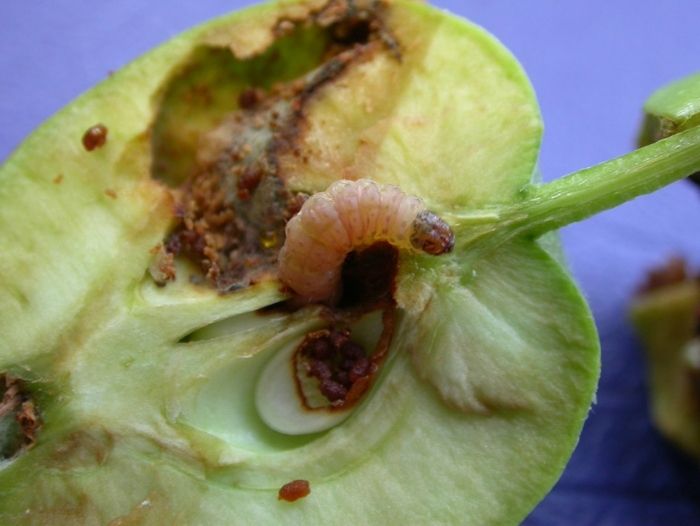
Codling Moth
Importance as a Pest on Apple: high
Other Fruit Hosts: crabapple and pear
General Info: Codling moths are the adults of the common “worms” that infest apples. These moths emerge from overwintering sites in the spring and lay their eggs on and near developing fruits. There are up to 3 generations per season, from spring to late summer.
Symptoms:
- frass (sawdust-like excrement) on the outside of the fruit
- small holes in fruit; and if still present, white larva in fruit
- fruit drop
- fruit rot that is associated with entry/exit holes
Management: The key to successful management by the backyard orchardist is a combination of cultural practices and accurately timed insecticide sprays. Cultural practices include fruit thinning, removing infested fruits, and bagging fruit. Codling moth activity depends on temperature, and the time to treat varies from year to year. To find out when codling moth is active in your area of the state and for spray recommendations, contact your local county Extension agent and subscribe to the USU IPM Tree Fruit Advisory. Insecticides include carbaryl, malathion, gamma-cyhalothrin, and spinosad.
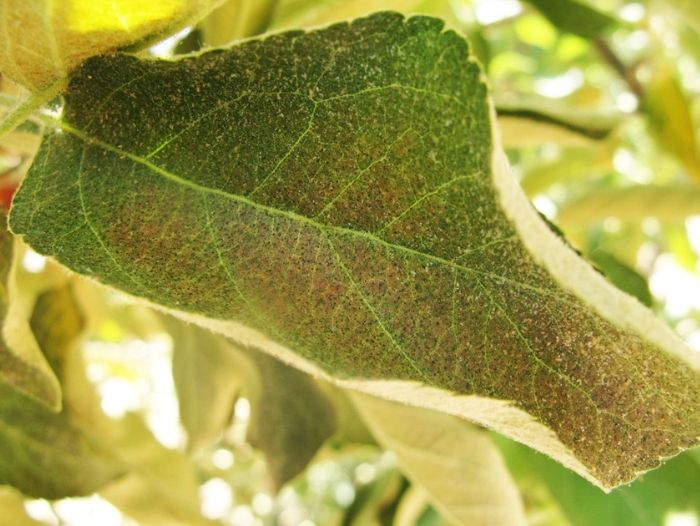
Spider Mites
Importance as a Pest on Apple: moderate
Other Fruit Hosts: all fruits
General Info: Mites are very small arthropods that are more closely related to ticks than insects. Spider mites overwinter as adults at the base of trees, or in ground cover, and may become a problem during hot, dry conditions in mid and late summer when they reproduce rapidly. They remove sap and chlorophyll from leaves causing a stippling appearance.
Symptoms:
- stippled leaves
- scorched leaves due to heavy feeding (shown at right)
- fine silk webbing that becomes apparent when populations are high
Management: Predatory mites that feed on spider mites can provide effective biological control if they aren’t harmed by pesticides. Low populations of spider mites can be ignored and are often kept in check by the predatory mites. Spider mite outbreaks often follow pesticide applications that upset the predator-prey balance. Options to reduce spider mite problems include washing down trees or plants with a stiff spray of water or applying insecticidal soap or 1% horticultural oil every 5-7 days. Avoid applying soaps or oils during the hot part of the day as some leaf burn may result.
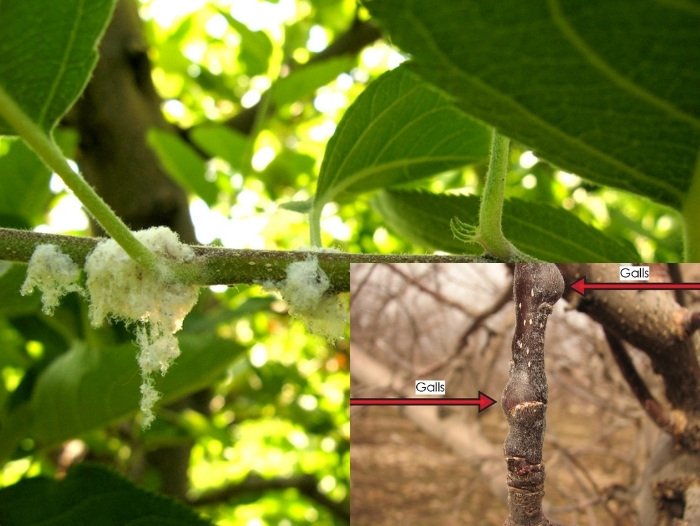
Woolly Apple Aphid
Importance as a Pest on Apple: moderate
Other Fruit Hosts: none
General Info: The woolly apple aphid overwinters on roots as well as in protected areas of the canopy. As the weather warms, they move up from the roots, and colonies in the canopy start multiplying. They first become noticeable in late June as sticky, cottony colonies (shown at top right) at the base of leaves, on old pruning cuts, or on cracks and crevices. Their feeding on twigs and roots causes galls (shown lower right). Extreme cold winters will kill most aphids overwintering in the tree canopy.
Symptoms:
- galls on roots and twigs that sometimes crack
- cottony masses on twigs and wounds
- honeydew
- curled leaves
Management: Woolly apple aphids are controlled with careful management. The key is to inspect apple bark carefully for the formation of new aphid colonies, and when they are found, treat them immediately with spot sprays. Conventional options are a pyrethroid (products ending in “thrin”) or carbaryl. An organic option is 1% horticultural oil mixed with the labeled rate of insecticidal soap.

Aphids
(Rosy Apple Aphid, Green Apple Aphid)
Importance as a Pest on Apple: low-moderate
Other Fruit Hosts: none
General Info: Aphids suck sap from the phloem vessels and reduce tree vigor. They exude sticky honeydew as they feed. Adults feed on leaves as well as apple fruits causing deformities. They overwinter as eggs on apple trees. Rosy apple aphid migrates to alternate weed hosts for the summer.
Symptoms:
- deformed fruit (caused by rosy apple aphid; colony shown at right)
- curled and sticky leaves and black sooty mold
Management: The home orchardist can usually ignore aphid infestations unless the populations are extremely high, growth of young trees is being stunted, or black sooty mold is staining the fruit. Numerous beneficial insects (e.g., lady beetles, lacewings, and syrphid flies) help suppress aphid populations, so conserve and protect these natural enemies. A 2% oil application when buds start to leaf out will smother eggs. In summer, insecticidal soap or 1% horticultural oil-works well.
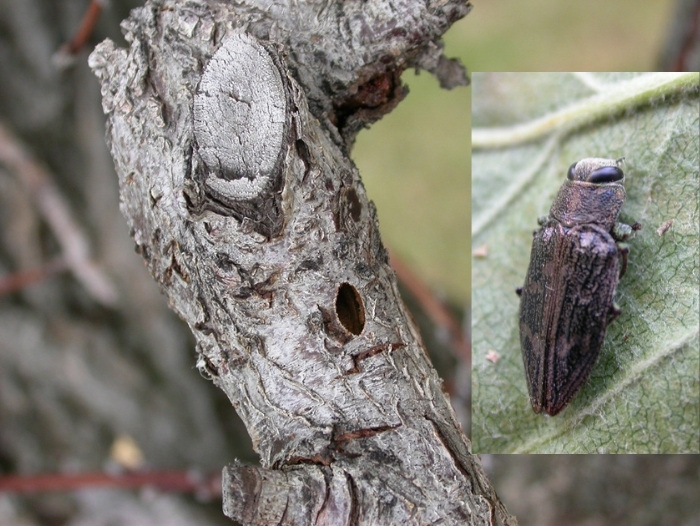
Flatheaded Borers
(Flatheaded Apple-tree Borer and Pacific Flatheaded Borer)
Importance as a Pest on Apple: low-moderate
Other Fruit Hosts: cherry and plum
General Info: Flatheaded borers are beetles (shown at right), usually only a problem on apples stressed by drought conditions, or when pest populations are high. The beetle larvae girdle trunks and can kill limbs and trees. The adult beetles are active in June and July.
Symptoms:
- sawdust-like frass (insect excrement) on bark
- loose, flaking bark
- large oval exit holes on large limbs or trunk (right)
- dead limbs
Management: Apply protective trunk sprays to prevent larvae from entering trees in June and July. Carbaryl, zeta-cypermethrin, or gammacyhalothrin are options. Keep trees healthy with optimal watering, fertilization, pruning, and removal of infested limbs and trees.
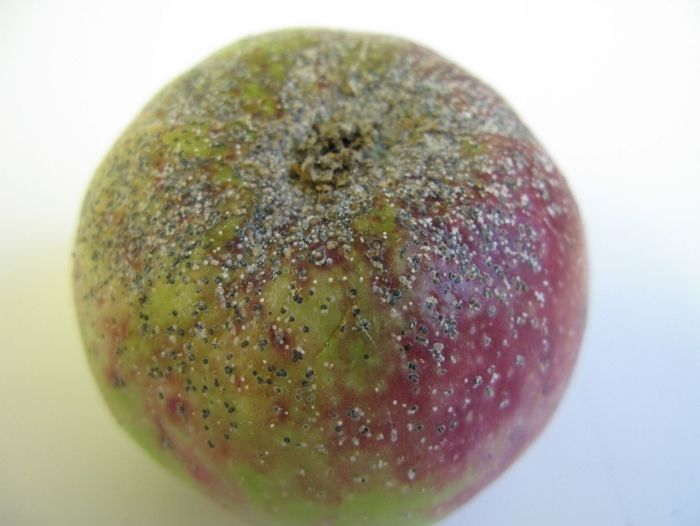
San Jose Scale
Importance as a Pest on Apple: low-moderate
Other Fruit Hosts: stone fruit trees
General Info: San Jose scale is the most common scale insect to attack apple. Scales will feed on bark and apple fruit, creating small red halos with white centers. The soft body of the insect is hidden underneath an armored shield. Females produce young that crawl from under the mother scale before settling to feed. The “crawlers” are active in the late spring. If heavy infestations are not controlled, a tree can be killed.
Symptoms:
- peppery-looking flakes on apple fruit (shown right) which are the scale bodies
- limbs encrusted with small, circular, black and gray armored scales
- small red halos with white centers on apple
Management: A 2% oil application at half-inch green stage will kill overwintering immature scales (but not adults). Adults are difficult to kill. To kill crawlers, apply a pyrethroid (products ingredients ending in “thrin”) or carbaryl in early June. (Adults die after crawlers hatch.) For non-chemical control, scrub branches with soapy water during the dormant season.
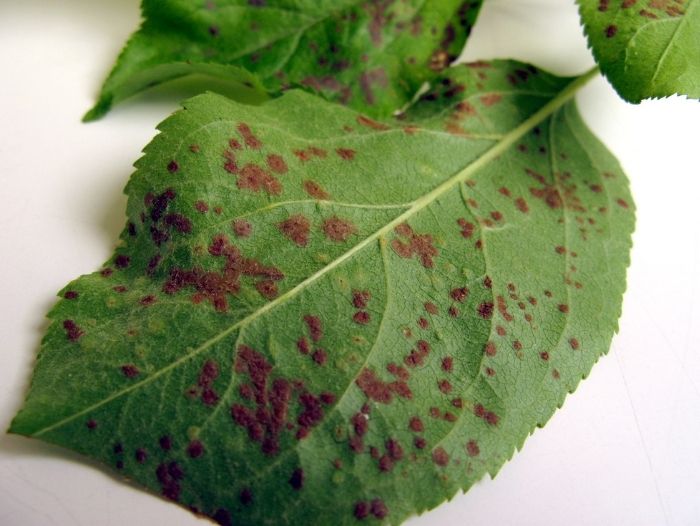
Apple-Leaf Blister Mites
Importance as a Pest on Apple: low
Other Fruit Hosts: crabapple
General Info: Blister mites are microscopic mites in the eriophyid group. They burrow under the lower surface of leaves and feed within small galls. Adults overwinter under leaf bud scales and emerge with new leaf growth in the spring. Very high populations can reduce photosynthesis and tree vigor. Trees easily tolerate lower populations.
Symptoms:
- “blisters” that start green and turn brown as they age (shown at right)
Management: Treat large infestations in early fall, before leaves drop. At this time, mites are migrating from leaves to buds and are exposed. Insecticide options include carbaryl, sulfur, or 1.5% horticultural oil.

Cat-facing Insects
Importance as a Pest on Apple: low
Other Fruit Hosts: pear and stone fruits
General Info: Lygus bug, stink bug, and boxelder bug sometimes feed on young fruits with their piercing-sucking mouthparts and cause depressions in the fruits by killing plant cells. These dead cells result in indentations and distortions in fruit shape as the fruits mature.
Symptoms:
- scarring that resembles a cat’s face with puckered cheeks (shown at right)
- pits and sunken areas on fruits
- reduced fruit quality and storability
Management: Usually cat-facing injury is not severe enough in backyard trees to warrant treatment.
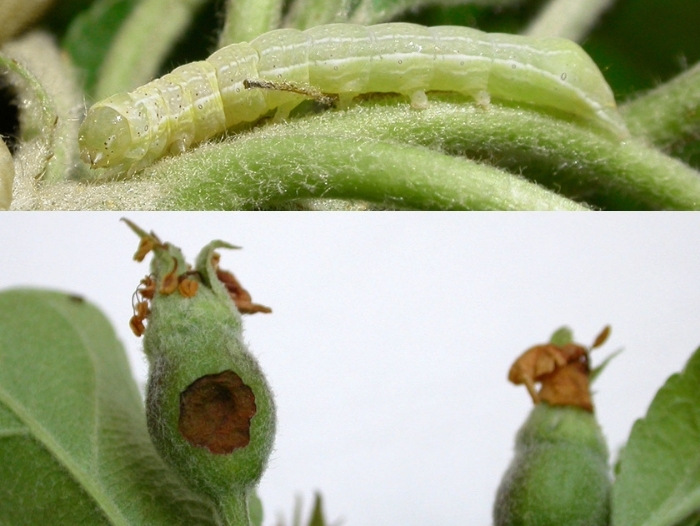
Speckled Green Fruitworm
Importance as a Pest on Apple: low
Other Fruit Hosts: cherry, pear, and plum
General Info: In Utah, the speckled green fruitworm is sometimes a pest of fruit trees. Young larvae hatch in spring and begin feeding on new leaves, flowers, and young fruit. They are active for approximately 6 weeks in spring and there is just one generation per year. The larvae can be detected by shaking branches over a tray.
Symptoms:
- chewed leaves
- early fruit drop
- round, deep holes in fruit (shown at right) that heal as a scar or sunken area
Management: A single application of a reduced-risk insecticide after fruit starts forming, such as Bt (Bacillus thuringiensis) or spinosad, is very effective. There are many brands of insecticides that contain these active ingredients.
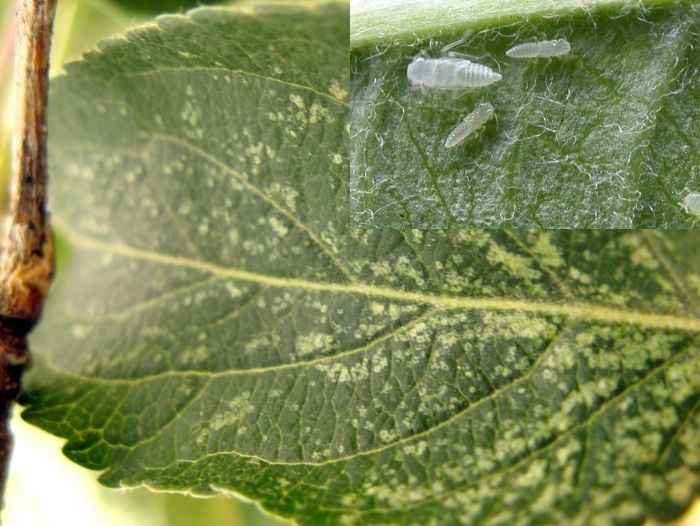
White Apple Leafhopper
Importance as a Pest on Apple: low
Other Fruit Hosts: cherry and crabapple
General Info: The white apple leafhopper sucks sap from leaves. The white flying adults can also be a nuisance when picking fruit. The adults are wedge-shaped with wings meeting in a sharp peak over the back. Nymphs are white and flightless
Symptoms:
- stippled leaves (yellow specks)
- black spotting on fruit (“tar spots”)
Management: Best control is achieved when leafhoppers are still in the immature stage (nymphs) in spring. Nymphs feed on the undersides of leaves, so good coverage of lower leaves with insecticides is necessary. Options include carbaryl, spinosad, or insecticidal soap(organic).



